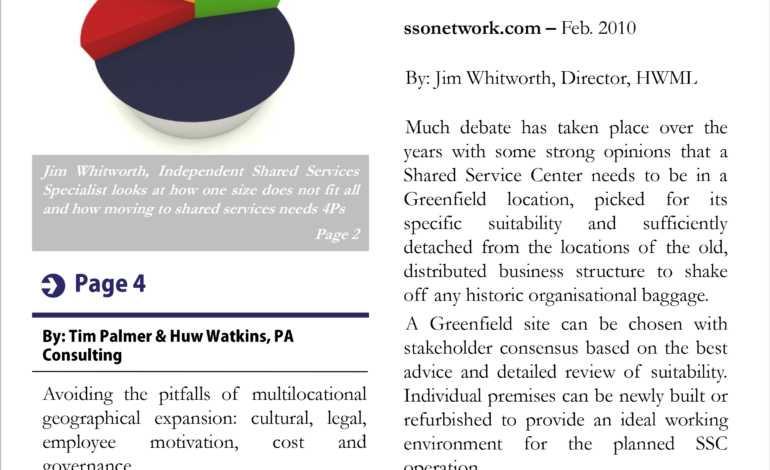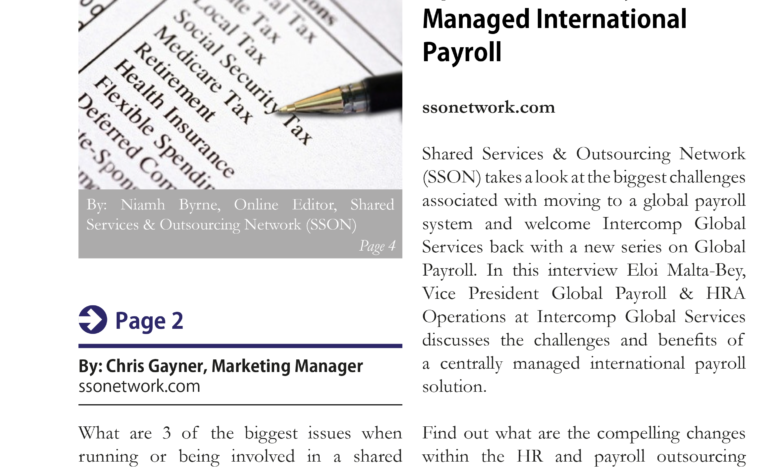ssonetwork.com – Apr. 2010
By: Niamh Byrne, Online Editor
As part of the Shared Services Optimization
Series, SSON speaks with the director
responsible for Siemens' Finance &
Accounting Shared Service Center.
Page 3
Dr. Daniel Spindler, Director of Siemens
Healthcare Diagnostics Services, has
been responsible for the Siemens Finance
& Accounting Shared Service Center in
Brussels since 1st May, 2009.
Anglo American has removed $2.3 billion
worth of costs, aided substantially by an
overhaul of its supply chain, asset
management and knowledge management.
It's now a seller's market for captive
shared services organizations, according
to an Alsbridge white paper by Paolo
Dias released this week.
The European Commission has called
for moves to make electronic invoicing
more accessible, particularly to smaller
businesses, as part of a wider drive to
bring down barriers to cross-border
electronic procurement.
Nos dias 25 e 26 de maio, acontece na
cidade de São Paulo a Conferência de
Centro de Serviços Compartilhados,
organizada pelo IBC, que discutirá
metodologias e técnicas para a
implantação de CSCs.
�systems, a Microsoft SQL Server database, EMC
Documentum enterprise content management and an
Information Builders Webfocus business intelligence
platform, among other systems. Managers access data
through an SAP single sign on portal. Effective operational
performance monitoring, van Tonder said, required “all
management levels to use the same set of reliable
information”.
By: Leo King
www.cio.co.uk
Anglo American has removed $2.3 billion (£1.5 billion)
worth of costs, aided substantially by an overhaul of its
supply chain, asset management and knowledge
management, and the introduction of shared services. The
metal and precious stones mining giant saved over £1 billion
by optimising how it uses its global sites, including through
the use of SAP enterprise asset management software in its
platinum division. Improvements to the group‟s supply
chain, and the introduction of a large shared services
initiative, equally played a part in the savings.
Anglo American cut a further £462 million through
productivity improvements, partly driven by changes at
subsidiary Anglo Platinum, where a five year knowledge
management transformation has taken place to improve
decision making. There have also been extensive
redundancies across the group, with 23,400 staff losing their
jobs last year.
As Anglo American announced 2009 profits had fallen 53
percent to $4.03 billion (£2.6 billion), it said a “leaner, more
effective structure” had helped deliver the savings. Chief
executive Cynthia Carroll said the company had become
“more focused and performance-oriented”. The reorganised
corporate headquarters in London, she said, “will be
responsible for providing strategic support to the businesses
and will be focused on delivering synergies, technology and
business performance”. The company was “continuing to
deliver clear and substantial value” in asset optimisation and
global procurement, she insisted, with cost control remaining
a “major focus”.
Anglo Platinum, a subsidiary of the group, has undergone a
series of cost and operational improvement initiatives in
recent years. A large knowledge management programme,
focusing on tracking information from mining through
refining and sales processes, aims to improve decision
making. Anglo Platinum began designing the programme
and architecture in 2004 to 2005, with systems delivering
benefits from 2008. At the Gartner Business Intelligence
Summit in London in February, Anglo Platinum‟s head of
information management, Johan van Tonder, said data was
“the most valuable asset we have”, assisting strategic
decisions and “sustainable change”.
The division uses SAP Netweaver business intelligence
systems,
By: Matthew Broersma
ZDNet UK , 28th April
The European Commission has called for moves to make
electronic invoicing more accessible, particularly to smaller
businesses, as part of a wider drive to bring down barriers
to cross-border electronic procurement. "(E-invoicing) is an
essential part of an efficient financial supply chain, and it
links the internal processes of enterprises to the payment
systems," the commission said in a statement. It estimated
the potential savings for businesses to be in the billions of
Euros each year.
The moves recommended by the commission include
changes to the regulatory framework to put electronic
invoices on the same footing as paper invoices. It also
wants improvements to interoperability and the adoption of
a common standard for invoice data content and forms
across the European Union. The commission made its
recommendations in a report prepared by its expert group
on e-invoicing and presented at a conference in Madrid.
The report predicted that within five to eight years,
structured e-invoicing will become the main invoicing
method throughout Europe.
The EU should focus its e-invoicing efforts on the needs of
small and medium-sized businesses, fostering the creation
of simplified electronic invoicing products with low
management costs, according to the report. The
commission also wants member states to harmonise the
regulatory framework applicable to e-invoicing. In addition,
more should be done to communicate the environmental
and savings advantages of e-invoicing, the commission said.
This could include the creation of a public-relations plan, as
well as the identification of organisations at the national and
international levels that could help push e-invoicing.
The e-invoicing initiative is ongoing and is backed by the
commission's Directorates-General of Enterprise and
Industry, Information Society and Media, Internal Market
and Services and Informatics, as well as the DirectorateGeneral for Taxation and Customs Union.
www.institutodegestao.com.br
�days for newcomers or Town Hall meetings for the entire
team. In addition, it was important for the understanding of
the Siemens culture and its values to move to the Siemens
Regional Company facility in Brussels. Before the move, we
were apart from Siemens and still felt and behaved like
different companies. Now we can easily get in touch with all
our colleagues, e.g. the corporate departments of Siemens
Belgium like Legal, Tax or Real Estate.
By: Niamh Byrne, Online Editor
ssonetwork.com
SSON: Daniel, what are the key drivers in the change
programme?
Dr. Daniel Spindler, Director of Siemens Healthcare
Diagnostics Services, has been responsible for the Siemens
Finance & Accounting Shared Service Center in Brussels
since 1st May, 2009.
He first joined Siemens in 1994. His areas of responsibility
covered various Controlling functions for Industry in
Regensburg as well as for Global Procurement and Logistics
in Munich. Two stays abroad in China and Canada enabled
intercultural experience. In 2004 he was granted a doctorate
by the University of Regensburg for his research in the field
of Fair Value Accounting under IFRS. From 2005 to 2007
he was responsible for the implementation of IFRS at the
Siemens Energy Group Power Transmission and
Distribution in Erlangen as well as for the Automotive
Group SiemensVDO in Frankfurt. Additionally he was
involved in the preparation of the IPO for SiemensVDO.
Prior to his appointment at Siemens Healthcare, he worked
for over two years for Audi in Ingolstadt, where he took
over responsibilities in external Group Reporting.
Furthermore he was in charge of the group-wide
implementation of an SAP BCS consolidation system.
SSON: Siemens Healthcare Diagnostic Services
(SHDS) has gone through a lot of change, especially
with the post-merger integration. Could you elaborate
on the change programme?
Dr. Daniel Spindler: Siemens in general have very high
standards and comprehensive guidelines on Compliance and
Corporate reporting. There are very intensive requirements
which have to be followed with regard to the monthly
Corporate reporting to our HQ in Munich. Siemens also
have detailed post-merger guidelines that allow new entities
to get familiar with the Siemens landscape; there is a list of
about 16 pages outlining what every entity has to implement
and to fulfil. When all instructions are implemented and
followed then an entity is fit to become part of the Siemens
world.
After a merger, the people also need to be brought on track.
To achieve this we conducted many meetings, like welcome
days
DS: The key driver of the change programme was the
change of mindset. It was a change towards the Siemens
world and its IT systems. One big project was for instance
the implementation of the Siemens Chart of Accounts
(CoA). Before we had the Dade Behring CoA, but mid
October 2009 was the go-live for the Siemens CoA. We now
also have in our local SAP system the Siemens CoA and we
don‟t have to convert anymore from the former Dade
Behring accounts to the Siemens accounts. This was one
very important step in fulfilling the central requirements, as
Siemens asks all entities worldwide to use the same
Corporate CoA.
Furthermore we are running through the 3D programme,
which means that all the company acquisitions that Siemens
made over the last three years, in order to build up the
Diagnostics business, are migrated into single entities. In
each impacted country the three former entities - DPC,
Bayer Diagnostics and Dade Behring - have to be merged. In
this context not only are there several legal mergers that need
to be performed, but also on the Finance side the entities
need to be merged.
SSON: What processes were standardized when
Siemens acquired Bayer’s diagnostic division, Dade
Behring and DPC?
DS: A high degree of standardisation was carried out on the
Finance and Accounting side, like implementing the Siemens
CoA and through the 3D programme.
SSON: How long did it take to integrate and to
standardize the two existing shared service centers, in
legacy country activities?
DS: The shift of the activities from the Global Shared
Service (GSS) Centre of Siemens is still ongoing. The former
Bayer Diagnostics part, which is currently serviced by GSS,
will be carved out by mid 2010.
SSON: Can you explain the set up that was there, and
how long did it take to integrate and standardize that?
www.institutodegestao.com.br
�DS: As mentioned above, Siemens acquired the three
entities DPC, Bayer Diagnostics and Dade Behring up to
the end of 2007. After the acquisition, the Bayer
Diagnostics part was serviced by GSS while the former
Dade Behring entities belong to the Shared Service Centre
in Brussels. Now almost two years later, we are still in the
process of migration and integration. However, in the
beginning in general the most important thing to do was
to integrate, but this also offers the opportunity to
standardise and we are taking the chance to do so now.
SSON: How long did it take to integrate the shared
service centre and legacy contract activities
proceedings?
DS: To date we have worked on this for roughly two
years and it will be completed in 2010. When the 3D
programme is finished all entities will run on one SAP
platform. Furthermore, all Siemens compliance
requirements and SOA requirements are already in place.
SSON: I believe this is likely to be fully completed by
the middle of 2010 – is that correct?
DS: Yes, the 3D program is still ongoing, but there are
just a few more countries which still need to be migrated.
We plan to finalise the migrations in June 2010. We
migrate country by country and this takes time, because
every migration must be prepared and conducted
precisely. In total it will take around two and a half years.
SSON: What were the main challenges in doing so?
DS: The main challenges were IT and Finance
adaptations, and secondly the associated ramp up of
Headcount. As already mentioned, it is crucial to fulfil all
requirements which Siemens demands, but the acquired
entities did not fulfil all these requirements in the past (e.g.
very extensive and strict Compliance rules). Siemens has a
lot of specific requirements related to Compliance as well
as SOX404 and, as is commonly known, Siemens was
going through a very rough time of bribery and
corruption. In this context Siemens has now installed very
high barriers in order to prevent bribery and corruption in
future. This means that a lot of processes are very strict
and require a lot of paperwork and a lot of signature
authorisations. To implement all these takes time.
SSON: Would you say that the challenges were
predominantly technical or people-related (when I
say "people-related", I mean change management)?
DS: I would say that the challenges were first of all very
technically related, but the changes had to be driven by the
people, so the challenges were also very much people
related. People need to understand all new technological
requirements, which especially in the SAP systems can be
very complicated and complex. In the first years we are
using the so called eConverter tool as a manual interface
between our local SAP system and the Siemens SAP
Business Consolidation System (BCS namely Esprit in
Siemens). As a result of these technical changes, the
people had of course to be trained and prepared, i.e. it was
essential to provide the necessary knowledge and
background. It was a huge task to train a lot of new
people coming from many different countries. As a result
the huge technical changes also had a high impact on the
people involved. One is linked to the other.
SSON: And did you incur any major challenges when
negotiating service level agreements?
DS: We recently went through the process of updating
our SLAs, because they were outdated after almost ten
years in place. These SLAs do not fulfil anymore the legal,
tax or transfer pricing requirements of Siemens. Therefore
we are currently aligning our SLAs with Siemens and
started an initiative to update our SLAs. We have worked
out a new charging model for our fees, which was agreed
with our customers. In the past we had a purely Sales
based charging model, while we now switch to a volume
or transactional based model. This model is a big change
and we are expecting big efficiency gains out of it.
SSON: Daniel, how do you handle negative reaction
when negotiating the SLAs?
DS: First of all we made all changes and especially the
charging model very transparent; we have also conducted
market comparisons where we analysed market prices of
competitors. We additionally aligned our transactional
charging prices with GSS of Siemens. Therefore, we are
now aligned with in house prices as well as with market
prices. Our overall charging fee is based on our actual
costs and contains a reasonable mark-up.
Overall the amount of our fees does not have any effect
on Siemens Group level, because it is purely an internal
charging. With the new SLAs we just change the allocation
between our customers while the overall charging amount
still remains unchanged. When moving away from a sales
based to a transactional based model, certainly some
entities will in future have lower charges while charges to
others increase. But in total for our Division nothing
changes,
www.institutodegestao.com.br
�changes, it is just the allocation between the customers
that changes. This leads to individual discussions with our
customers, especially when they will be getting higher
charges in future. As the prices are based on GSS and
external market evaluations they are competitive prices
and reflect the services rendered.
SSON: How does the retained organization look
now? I mean, what suggestions make for a smooth
transition?
DS: Siemens has three different sectors: Energy, Industry
and Healthcare. Additionally there are cross sector services
where for instance GSS belongs to. Siemens has many
shared service centres within GSS which is operating on a
global basis. GSS is rendering services to all sectors, that‟s
why they are called cross sector services.
SSON: For members of organizations reading this
who are thinking of merging with other
organizations, what advice would you give for a
smooth transition?
DS: Communication in my opinion is the key to success,
because with a lack of communication people will not
really be aware of what needs to be done and in which
manner. The difficulty with our merger was that there was
no former Diagnostics business and in this context there
existed nothing to be integrated into - it was a newly built
up Division coming from three acquired entities on
different continents and cultures as well as having three
different IT systems. This new Diagnostics Division has
around 3.5 bn Euro revenue and more than ten thousand
people who now need to work together.
As this Division is completely new, it is also very exciting.
Diagnostics is very different to all other divisions Siemens
has. First of all, the Finance headquarter is in the US,
while all other Division headquarters are located in
Germany. That means Diagnostics has a very different
culture and philosophy. And as is always the case, it is
important that all people work close together, especially in
this post merger situation. It is very important to give all
people the required knowledge and it is not sufficient just
to send out some emails or instructions. It is really very
crucial that people with Siemens experience go to the local
sites and help to implement all standards.
I have realised that even after one and a half years, some
people still do not fully understand how the end to end
processes work. If nobody explains the entire process to
you, how will you then know what part of the process
chain might be wrong or even missing? We have
experienced instances where parts of the standard
processes
processes were not yet implemented, which unnecessarily
led to huge amounts of manual efforts. Therefore,
somebody should be available until all tools and processes
are completely implemented and the people are trained.
Again, communication is the most important thing,
especially if you imagine that a small entity is coming to a
very huge and complex entity like Siemens. For sure it is
not easy to find out the right people to contact. There are
so many different Corporate departments and most of
them are based in Germany. For the people it is often
difficult to find the right contact person in case of
questions.
SSON: Why did Siemens decide to go into
diagnostics, and take over three different areas of
very established companies?
DS: This is a very good question; Siemens had the strategy
to enter this promising business derived from the
megatrend „aging population‟ and its growing need for
Healthcare. Siemens historically was very strong in the
classical Imaging business, i.e. in-vivo Diagnostics, as well
as in the field of Workflow & IT solutions. In-vivo means
taking photos of the human body, like using Ultrasound
or Computer Tomographs. However to become an
integrated Healthcare supplier, it was essential also to
operate in the field of the in-vitro Diagnostics, i.e. where
substances coming out of the body, like fluids and blood,
are analysed. Now with Imaging, Diagnostics and
Workflow & IT Solutions, Siemens can offer the full range
of diagnosis. So in vitro and in vivo diagnosis come
together and this has the advantage that e.g. the Sales
people from in-vitro can also offer in-vivo and vice versa.
With this approach the Sales departments from each
Division get access to many customers and the customers
on the other hand get the full product range out of one
relationship.
SSON: What functions are consolidated into the SAP
platform?
DS: General Ledger Accounting, Accounts Payable,
Accounts Receivable, Cash and Bank, Intercompany
Clearing and Fixed Assets are definitely the main
functions. The SAP systems furthermore provide the full
range from Finance & Accounting, Procurement,
Logistics until Sales. Within Accounting & Finance the
major parts are running on SAP, while one exception is
some source data for the internal Management reporting,
which still comes from various other systems outside SAP.
However, it is our target that all reporting requirements
should be handled in SAP. For instance we do our
monthly closing on a local SAP system, which is then
loaded into Esprit. In Esprit the Group figures are then
ultimately consolidated.
www.institutodegestao.com.br
�SSON: How easy was it to implement that?
DS: It is probably more reasonable to ask how difficult it
was. It was indeed pretty difficult, because all three former
companies for instance had different CoAs. Furthermore
Siemens already had its own SAP systems mainly adapted
to the needs of an electronic company not covering the
special needs of a Diagnostics business. Although parts of
the SAP landscape are similar to what Dade Behring had,
there is still a big gap between the systems. For example,
our local SAP system does not yet have development
codes or functional areas. Apart from these examples,
there are even more outstanding topics that are necessary:
in the final stage - it is our target to have an automated
interface between our local SAP system and SAP BCS.
Without this interface we have to convert the data and
make many adjustments within a manual interface called
E-converter. This can only be a preliminary solution and
needs to be replaced. With the second phase of the CoA
implementation we also want to implement this automated
interface.
SSON: What are your priorities for shared services in
the next five years?
DS: Looking back I can say that there is always a lot of
need for consulting services, especially if we talk about
very dynamic companies; e.g. Siemens is a company with a
lot of M&A activities and therefore a lot of changes. I can
easily imagine that the current Diagnostics SAP platform
will sometime be integrated into the existing Siemens
systems already running for the Healthcare sector.
Currently there are different SAP systems and different
business models within the Healthcare sector, which all
need to grow together.
SSON: And how long do you think that will take
for you to go into that?
DS: This depends mainly on how long the current SAP
systems, which are tailored for Diagnostics are in place,
presumably the next two to three years.
SSON: So once the SAP evolves, so you are working
off the same platform - then you can be brought in
and integrated?
DS: Exactly, to integrate the Diagnostics Division into the
classical Healthcare business one common platform is the
key success factor.
SSON: A long journey ahead of you, but it sounds
like you have done so much in the last two years
anyway.
DS: We did a lot, but this is just the basis for the new
tasks yet to be done. Now we have to take the next steps,
and one of the next big steps is to adapt to the existing
Siemens SAP systems. From a cost perspective, it makes
sense in the end to operate on one Siemens SAP platform.
By: Paolo Dias
Sourcing Shangri-La Blog , 23th April
It's now a seller's market for captive shared services
organizations, according to an Alsbridge white paper by
Paolo Dias released this week:
'2010 should be a great year for the captive acquisition
market. Many outsourcers (particularly the Indian-based
outsourcers) have the balance sheets to go on a back
office services shopping spree'.
Recent deals, as the Alsbridge white paper notes, include
Citigroup's
disposal
of
its
global
business
services captive to TCS, and Aviva's sale of its GS unit to
WNS.
Which reinforces something that I suspect all the best
shared services directors always knew: that shared services
is very much a journey. It may be a very long journey lasting a decade or more perhaps - but, outside possibly
the public sector, the ultimate destination is almost
certainly an offer from an outsourcer that the CFO just
can't refuse.
This sense of a journey helps right from the start. Shared
services implemented as a one-off re-organization or, even
worse,
as
the
one-off
implementation
of
a software package implementation, were always heading
for the rocks.
The journey idea helps in other ways too. Shared services
can then be seen as a business strategy with multiple
payoffs, not as careering towards some sort of oblivion
[there is life after disposal].
It also frames shared services directors as what they really
are - entrepreneurs. They are building new businesses
within their existing organizations that will likely one day
be sold. If they do it well, the payback to the organisation
during the build phase and at the eventual sale can be very
www.institutodegestao.com.br
�substantial. 'Back office?' - phooey. The best shared
services directors are extraordinary value creators.
In that context, it makes sense to keep a close eye on the
competition.
Firstly, because knowing what will
tempt outsourcers to pay premium prices for a
captive could shape many aspects of how the shared
services organization is built.
Secondly, and equally importantly, at every stage along the
shared services journey, the CFO will be receiving
proposals from outsourcers claiming that they can do
more-for-less, and automate faster, and generally
do everything better. If a captive organization continues
to fall behind what is available from the outsourcers, then
its days are numbered.
The anecdotal evidence is that many shared services
organizations are falling behind. Many have unhappy
internal customers and poor customer engagement.
Launched as 'one-off' innovations in the delivery of one
service line, they seem often to struggle to
manage expansion to a wider scope, while at the same
time delivering the continuous service improvement and
cost reductions that their internal customers expect.
Thinking like the competition provides clues to how
shared services organizations can drive performance
improvement. Outsourcers can't hide costs through loose
transfer pricing mechanisms. And if they don't keep their
clients happy at every stage - from onboarding through
to ongoing innovation in service delivery - then they will
walk.
The only conceptual difference between a shared services
organization and an outsourcer is that one has internal
customers, while the other must compete in the
marketplace for its customers.
management
and
continuous
performance
improvement.
They know that, in the long
run, frameworks of this kind are essential
to deliver sustainable improvements and happy
customers.
Visagio, 30 de Abril, 2010
Nos dias 25 e 26 de maio, acontece na cidade de São
Paulo a Conferência de Centro de Serviços
Compartilhados
(CSCs),
organizada
pelo
IBC
(International Business Communications), que discutirá
metodologias e técnicas para a implantação de CSCs.
A consultoria Visagio, que é uma das patrocinadoras do
evento, mostrará a diferença entre CSCs e a simples
centralização de serviços, erro muito comum nas
empresas. A consultoria irá expor um pouco da teoria e da
sua metodologia, além de apresentar em parceria com a
Endesa Brasil o case bem sucedido de um dos maiores
grupos no setor de geração e distribuição de energia do
mundo.
O evento acontece no Hotel Tryp Paulista (Rua Haddock
Lobo, 294), Cerqueira Cesar, São Paulo. Também
participam empresas como Vale, Braskem, Gafisa,
Odebrecht e Brasil Foods. Mais informações:
http://www.informagroup.com.br/pt/event/show/id/10
77/evento/DS0901510
So what are the hallmarks of successful outsourcers, and
where are they headed next? Well, I would say this, but I
see one of the distinguishing features of successful
outsourcers is that they have, or are striving to complete, a
comprehensive and integrated view of the customer
journey and the whole process lifecycle. They think endto-end.
Editores
Rodrigo Lang
Vanessa Saavedra
Conselho Editorial
The recent case study from Computacenter shows how
one outsourcing and managed services provider has
invested in building a framework for process
management as a critical underpinning for operational
efficiency and continuous improvement in the customer
experience. And this is typical. All outsourcers are striving
to build collaborative frameworks for process
management
Caio Fiuza
Eduardo Saggioro
Vitor Marques
Contato: pesquisas@visagio.com.br
www.institutodegestao.com.br
�
Shared Services News | Edição 11
Posts relacionados
Até 2017, previsão é que pelo menos 73% dos Centros passem
Pressão pela produtividade tem levado diretores e gestores de CSCs a
Atividades de TI como atendimento ao usuário, operação de sistemas e












